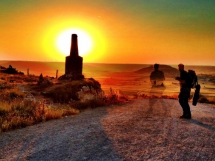| Camino 8 Days Trip |  |


Day 1: Arrival Sarria
Arrive in Sarria. Your trip starts with your arrival in the town of Sarria, located in the province of Lugo - just over 100 kilometers from Santiago de Compostela. There are a number of ways to reach Sarria. There is a direct overnight train from Madrid to Sarria or alternatively you can take a bus from Madrid city or Madrid Airport to Lugo (5-6 services per day/5-6 hours) and connect with a local bus service from Lugo to Sarria (7 services per day/25km). There is no walking scheduled for today, so you can arrive at any time; however, we recommend you arrive with ample time to collect your Pilgrim Passport. See the ‘Important Information’ section of your pre-departure document for more information on the Pilgrim Passport). For dinner we recommend trying the charming restaurant at the Hotel Roma in Sarria, which serves a range of delicious regional fare.
Day 2 : Sarria - Portomarin ( 21,2km)
Today you begin the first stage of your walk. Through the course of the week you will become very familiar with the yellow arrows and scallop shell symbols that guide you. For centuries the shell has been the symbol of the Camino and there are a few interpretations of its meaning - from mythical and metaphorical to practical. Perhaps it’s simply a souvenir that pilgrims like to take back to their place of origin. The walk today takes you pass many small hamlets. As you walk along the Rua Maior (Maior Street) to the Magdalena Monastery and cross the beautiful Bridge of Aspera, you are actually bidding farewell to Sarria. Continuing through beautiful countryside and crossing a small idyllic stream, an uphill climb takes you to the villages of Vilei and Bardadelo. Barbadelo’s church is a perfect example of rural Galician Romanesque architecture. The Camino then winds along a dirt track through farming fields flanked by trees. As you walk through typical Galician countryside, you pass through the hamlets of Leimán and Peruscallo. The section from Peruscallo to the village of Brea (the official 100km mark) is one of the most beautiful sections of the route. As you continue through Mirallos, you arrive at Penas and then take a downhill stone track to Moimentos, followed by Mercadoiro, Moutros, Parrocha and Vilachá, before a steep descent sees you arriving at Portomarin – a town full of history and your base for the night. After the construction of a dam on the Miño River, the town was abandoned with its remains resting under the water of the river. When water levels are low you can see a few of the old buildings and the old bridge. Today the village of Portomarin sits in the upper part of town and its imposing church of San Nicolás and the smaller church of San Pedro were moved to their new locations stone by stone… an impressive feat.
Day 3: Portomarin – Lestedo (19 km)
With the Church of San Nicolás in your shadow, you leave Portomarin today and make your way to Lestedo. Following a beautiful uphill track and then along a road for a short section, an ascent takes you to a local farm and then to the town of Toxibo, where you will come to a very well-preserved ‘hórreo’, which is a typical granary on stilts that is found in northern Spain. At the village of Gonzar you have to opportunity to stop for a rest at a peaceful pilgrim rest area. After you pass through Gonzar, a steep uphill trail takes you to the small village of Castromaior. Soon you reach a milestone that marks the 80-kilometre mark. From Ventas de Narón, a short ascent takes you to Monte de Ligonde. Once at the top you will take a downhill trail to Ligonde and then ascend to Eirexe. From here you make your way to Lestedo - a very peaceful spot where you will stay in a special 'feature stay' property.
Day 4: Lestedo – Melide ( 19km)
Today the Camino follows the path from Lestedo to Melida. An uphill climb firstly takes you to Os Valos before you slowly descend to the pretty town of Palas de Rei, one of the most important towns on the pilgrim’s route in Galicia. It’s large and partially canopied town square is the focal point of the town and is home to a town hall, which is made from a mix of granite and whitewash render - a typical example of architecture of the region. Leaving Palas behind you then enter beautiful rural countryside and farm land on your approach to the charming village of San Xulián. The trail then leads you through oak grove to the charming town of Casanova and you are soon at the border of the provinces of Lugo and A Coruña. When you reach Leboreiro you will notice its modest Romanesque church. Inside is a carved image of the Virgin Mary. In Furelos, you come across a four-arch medieval stone bridge. Your final destination today is Melide, one of the largest towns on the pilgrim’s route in Galicia.
Day 5: Melide – Arzua (14km)
Firewalling Melide , you wind your way along quiet country roads and through beautiful countryside bound for the city of Arzúa - the spot where the Camino Frances (French Way) meets the Camino del North (North Way). En route you pass the ancient pilgrimage villages of Boente, Barona and Vilantime. Crossing a bridge, a downward path leads you to the interesting restored village of Ribadiso on the banks of the Iso River before arriving at Arzúa - your base for the night. A small park in the town is a popular meeting point for the locals and provides an interesting insight into local village life. Some of Arzúa’s main monuments include the 14th century Capilla de la Magdalena and the 20th century Iglesia de Santiago. It’s recommended that you try some of the area’s famous cheese (‘queixo’ in Galician or ‘queso’ in Spanish) whilst in Arzúa – it’s available for sale in many of the town’s shops and restaurants.
Day 6: Arzua – Rua (19km)
Today you complete one of the final stages of the Camino de Santiago. This stretch of the walk sees you passing through agricultural meadows, landscapes of oak and eucalyptus and a collection of sleepy villages such as Ferreiros, Boavista, O Castro and Salceda. Soon after Salceda, you pass a monument dedicated to the pilgrim, Guillermo Watt, who died at this point when making his pilgrimage to Santiago. Next you pass through Xen and Ras into Brea. From Brea, you continue along the road to Santa Irene. A highlight of the day is a visit to the beautiful chapel of Santa Irene with its unique statues of St James (Santiago). A continuous, quiet country road then takes you eventually to your next stop, Rúa, one of the quieter places before Santiago de Compostela.
Day 7: Rua - Santiago De Compostela (18km)
Today you embark on the final and key stage of the Camino de Santiago with your ultimate goal, the city of Santiago de Compostela, in your sights. After leaving Rúa, you pass through San Paio and then the village of Lavacolla. In ancient times, pilgrims would wash in the stream at Lavacolla before continuing their journey to Santiago. An uphill climb takes you to the village of Vilarmaior, then a gradual ascent sees you reach Monte do Gozo. It’s at this point that ancient pilgrims experienced their first views of the towers of the Cathedral of Santiago. This is a great spot to sit back, reflect and enjoy a well-earned rest before leaving the rural landscapes behind and heading into the urban sprawl of the city. As you come to the end of the final leg you walk through the town to the magnificent Plaza del Obradoiro and then to the gates of the Cathedral of Santiago de Compostela. The cathedral during medieval times was considered the third most important place of pilgrimage after Jerusalem and Rome. Today it is the jewel of the city and an exquisite example of Romanesque architecture. After you’ve rested and rejuvenated yourself, take the time to enjoy a wander around the old historic quarter of this culturally rich city. Other fine buildings of note in the Plaza de Obradoiro include the 15th century Hostal de los Reyes Católicos, which was once a pilgrim hostel and then a hospital, but today used as a ‘parador’ hotel. The 18th century Pazo de Raxoi is another impressive building in the plaza. You may wish to collect your Compostela certificate when in Santiago today, which is obtainable if you have stamps in your Pilgrim’s Passport as proof that you completed the last 100 kilometers of the Camino de Santiago. (Further details on obtaining this certificate and directions on finding the Pilgrim’s Office can be found in your detailed route notes).
Day 8: Departure Santiago de Compostela
Your rewarding journey ends after breakfast in Santiago de Compostela. Transfer to Airport







